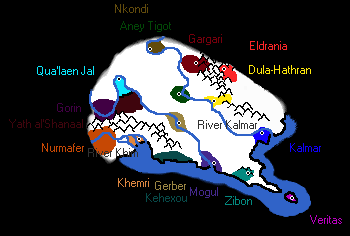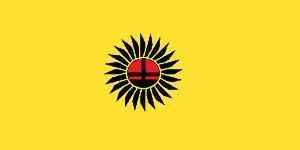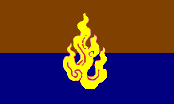Spoiler The Story so Far :
On one small arm of a spiral galaxy, in the solar system of a middling-sized sun, there is something unique.
Humanity.
Countless millennia ago they first appeared, roaming around the world. In a few rare locations, they settled.
Nations arose. Khemri, Lords of the Setting Sun, Veritas, Children of the One, and many more.
For centuries, the nations of this 'Cradle of Civilization' grew and prospered. Conflicts broke out. The weak were assimilated by the strong. From the northwest, the isolated Eldranians contacted the rest of the world. Refusing to accept that there was other human life, they struck into the cradle. Many nations and countless people fell before them, but they could not support their war forever. The great nation of Veritas brought together a coalition, and destroyed the Eldranian threat forever.
Following the fall of Eldrania, the world fell under two spheres of influence. Khemri and its Crystalist allies in the west, Veritas and its Oneist Supporters in the east.
Tensions hit their breaking point when Khemri invaded the sovereign nation of Nurmafer. Veritas took advantage and attacked Khemri's cities while its armies were away.
A war broke out, a war that is known to this day as the Great War.
Tides of battle ebbed and flowed, but over time, the economically stronger Crystal Ridge alliance of Gorin, Shalamari and Khemri proved to be too much. Veritas was defeated, split into minor successor states. Some Veritasians left their old home, to found new nations in distant lands.
Very briefly, the CRA reigned unchallenged. But an enemy that was to prove more than a match for them appeared in the north.
The Lengels, mighty nomadic cavalry warriors, poured into the northern cradle in incredible numbers. Weaker nations were quickly conquered and assimilated.
The Lengels seemed unstoppable. The hooves of their steeds trod all over the northern reaches of the cradle. Some nations were conquered, and many of the nations not directly affected by the Lengels found themselves fighting amongst each other.
Signing peace with Gorin and Khemri, the Lengels made their last great offensive, into the Jungles of Cultesia. It brought the Bladeists to their knees, but were halted by disease.
Then, the Lengels began to fracture. The northerners, disgusted by the alien culture impurifying their nation, declared their independence. Khemri and Gorin didn’t waste a second in acting. Both attacked the Lengels, rapidly pushing back the Lengel borders. Eventually, the Lengelzai’s forces were defeated, and for a time, peace would reign in Northern Terrania.
Meanwhile, in the south the growing Republic of New Veritas fought against the growing power of Guangfei, and the Bladeists. A growing tide of pan-Valin sentiment swept through the Exarchates throughout this time of warfare, leading up to their reunification.
The Valin Republics of Veritas set out in an ambitious campaign to retake their homeland, beginning the War of the White Rose. Veritas and Ardan, on the Oneist side, made large early gains but could not hold up the war effort. While Veritas tenaciously held on to its homeland, it lost the southern Republics one by one to the Bladeists, and Ardan lost Davar.
However, the aggression of the strongest Bladeist nation, the Swade Ascendancy, would be its downfall. It set out on a fanatic program to exterminate all Oneists, including those under the protection of its allies. All of the nations still involved in the war fought against the extremist Swades, resulting in their destruction.
Just a few centuries after the fall of the First Lengel Horde, Tellus is both very changed and very similar. Gorin and Khemri remain the strongest nations, though the younger nations of the south are rapidly catching them. The power of the Oneists is broken, and they are on the verge of turning on each other. Trinlinism and Bladeism are on the rise. Guangfei is as powerful as ever, but its neighbours are growing stronger as well. All the while, the nations of Azulia are all waxing in power, some already rivaling Old World nations in strength.
The balance of power is greatly shifted, and the future of this world is more difficult to predict than ever.
Humanity.
Countless millennia ago they first appeared, roaming around the world. In a few rare locations, they settled.
Nations arose. Khemri, Lords of the Setting Sun, Veritas, Children of the One, and many more.
For centuries, the nations of this 'Cradle of Civilization' grew and prospered. Conflicts broke out. The weak were assimilated by the strong. From the northwest, the isolated Eldranians contacted the rest of the world. Refusing to accept that there was other human life, they struck into the cradle. Many nations and countless people fell before them, but they could not support their war forever. The great nation of Veritas brought together a coalition, and destroyed the Eldranian threat forever.
Following the fall of Eldrania, the world fell under two spheres of influence. Khemri and its Crystalist allies in the west, Veritas and its Oneist Supporters in the east.
Tensions hit their breaking point when Khemri invaded the sovereign nation of Nurmafer. Veritas took advantage and attacked Khemri's cities while its armies were away.
A war broke out, a war that is known to this day as the Great War.
Tides of battle ebbed and flowed, but over time, the economically stronger Crystal Ridge alliance of Gorin, Shalamari and Khemri proved to be too much. Veritas was defeated, split into minor successor states. Some Veritasians left their old home, to found new nations in distant lands.
Very briefly, the CRA reigned unchallenged. But an enemy that was to prove more than a match for them appeared in the north.
The Lengels, mighty nomadic cavalry warriors, poured into the northern cradle in incredible numbers. Weaker nations were quickly conquered and assimilated.
The Lengels seemed unstoppable. The hooves of their steeds trod all over the northern reaches of the cradle. Some nations were conquered, and many of the nations not directly affected by the Lengels found themselves fighting amongst each other.
Signing peace with Gorin and Khemri, the Lengels made their last great offensive, into the Jungles of Cultesia. It brought the Bladeists to their knees, but were halted by disease.
Then, the Lengels began to fracture. The northerners, disgusted by the alien culture impurifying their nation, declared their independence. Khemri and Gorin didn’t waste a second in acting. Both attacked the Lengels, rapidly pushing back the Lengel borders. Eventually, the Lengelzai’s forces were defeated, and for a time, peace would reign in Northern Terrania.
Meanwhile, in the south the growing Republic of New Veritas fought against the growing power of Guangfei, and the Bladeists. A growing tide of pan-Valin sentiment swept through the Exarchates throughout this time of warfare, leading up to their reunification.
The Valin Republics of Veritas set out in an ambitious campaign to retake their homeland, beginning the War of the White Rose. Veritas and Ardan, on the Oneist side, made large early gains but could not hold up the war effort. While Veritas tenaciously held on to its homeland, it lost the southern Republics one by one to the Bladeists, and Ardan lost Davar.
However, the aggression of the strongest Bladeist nation, the Swade Ascendancy, would be its downfall. It set out on a fanatic program to exterminate all Oneists, including those under the protection of its allies. All of the nations still involved in the war fought against the extremist Swades, resulting in their destruction.
Just a few centuries after the fall of the First Lengel Horde, Tellus is both very changed and very similar. Gorin and Khemri remain the strongest nations, though the younger nations of the south are rapidly catching them. The power of the Oneists is broken, and they are on the verge of turning on each other. Trinlinism and Bladeism are on the rise. Guangfei is as powerful as ever, but its neighbours are growing stronger as well. All the while, the nations of Azulia are all waxing in power, some already rivaling Old World nations in strength.
The balance of power is greatly shifted, and the future of this world is more difficult to predict than ever.
Welcome to...
LINESII- Into the Darkness- Part III
I'd like to say that everyone is welcome to join this NES at any time, there's no player limit. NES newbies, you may join, the other NESers and I will show you the ropes. My only request is that you don't just pop in for one turn and wreak havoc by taking over a powerful NPC and wiping out a bunch of neighbours or something like that.
So without further ado, the rules!
Economy
Economy comes from 2 places. Cities, and land, represented by Rural and Urban Economy. 1 Rural Economy point for each region a nation owns. Each special city (I'm using the 3 City system developed by Thlayli, Israelite9191 and Toteone/Camille/Totamille/JessicaKathrinn) will provide one economy point.
Example: You have 1 regional economy point to spend at the beginning of the game. You found your first cities and your nation begins to grow. Rural economy increases as you grow larger, Urban as you get more special cities.
Economy will be shown like this: Total economy- Rural economy/City economy
Military
3 stats. Army, Navy, and UU. As ages advance and more powerful units emerge, units become more powerful. I will use a numerical system. Example: Warrior has (1) power, Spearman has (1.5), Swordsman has (3)... And if you write stories about your units' terrific strength, they may get a little power bonus. 1 economy point will train 1000 soldiers or 10 ships.
With UUs, simply describe them to me and I'll put them into your stats.
Ages and Unit Power
Stone Age
The dawn of civilization. Many armies are mere rabbles of warriors, but the spear is rising as a powerful weapon. Also, hunting bows are beginning to be used for military purposes.
Warrior (1), Spearman (1.5), Archer (1.5)
Copper Age
Spearmen dominate the battlefields of the world, but the war-axe is beginning to erode to spear's might. The strengthening bow, as well, is becoming a stronger and stronger counter to the more lightly-armoured axemen. In some regions, cavalry makes its first appearance.
Archer (1.5), Spearman (2), Axeman (2.5)
Bronze Age
All weapons are gaining in strength, but the golden age of the spear is waning. Axes remain very powerful, but they themselves are under threat from the first swords. Early siege weapons are developing.
Archer (2), Spearman (2.5), Axeman (3), Swordsman (3), Horse Archer (4.5)
Iron Age
The sword is the new supreme weapon on the battlefield. The spear and arrow remain as they always have been, but the axe is gradually disappearing. For the first time, melee cavalry is developed.
Archer (2), Spearman (3), Axeman (3.5), Swordsman (4), Horse Archer (4.5), Cavalry (5)
Imperial Age
New technologies both domestic and military define this age. Great works of architecture are completed, as are designs of new military weapons. Siege weapons are growing ever stronger. This age will likely define the path of military technological development in the future.
Archer (3), Spearman (4), Axeman (4.5), Swordsmen (5), Horse Archer (5), Cavalry (6)
Note: Several units are more expensive: Bajo-Oni (10/Eco Point), Bigun (5/Eco Point), Pentareme (5/Eco Point), Titan (5/Eco Point)
Population
Is now a word-based stat. Here are the levels.
Tiny - <50 000
Small- 50 000-250 000
Medium- 250 000-1 500 000
Large- 1 500 000-10 000 000
Huge- 10 000 000-100 000 000
Massive- 100 000 000-1 500 000 000
Colossal- >1 500 000 000
Conscription
You can enlist a portion of your population to fight for you. You can ask for a certain number, and I will determine how many heed your call. You can also draft, but this is less popular.
Generally, if these forces are successful, there is no confidence damage, but if they fail, you suffer both economic damage (from less workers) and a loss of confidence in your rule.
You can request a conscription in your orders and give a request of how many you soldiers you want to raise. I will determine how many come to fight for you.
Education
Having an intelligent population can give you many advantages. Education levels 1-3 cost you 1 economy point per turn. Education levels 4-6 cost you 2 economy points per turn. Education levels 7-9 cost 3 economy points per turn. Education level 10 costs 4 economy points per turn. It costs 1 EP to raise education 1 level, plus maintenance.
Culture
This stat is a sentence description of your nation's ethnic and religious composition.
3 City System
Building a city costs 1 economic point.
Economic centers- Cities surrounded by red, these provide you with one economy point per turn.
Cultural centers- Cities surrounded by blue, these provide you with one economy point per turn and random culture and education levels. These cities are quite bad to lose.
Religious centers- Cities surrounded by green, these cities provide you with one economic point per turn and are the beating hearts of your religions. They provide great bonuses to culture, confidence, and the spread of your religion, but are devastating to lose.
Wonders
At great expenditure, you may create mighty monuments to you and your nations power. You must pay economy points to build them, and they can't be rushed.They have great cultural and confidence bonuses, but won't produce troops and give you spending points for no reason. Wonders often create specialty cities.
Government
Your government.
Religion
You start off with a default primitive animism, belief in spirits of nature and things like that. You can create a more advanced religion through a story and the construction of temples. Religions are every bit as powerful here as they are in our world. They give your leader credibility, mold alliances, and break empires.
At this point, there are already several strong, established religions, but religion is an oft-changing thing. New sects can arise, and some faiths fade away.
Stories
I don't give direct bonuses, like +10 galleys, but stories will have positive effects on your nation during the update, maybe giving you a new economic center, better battle results, and the like.
Orders
1 PM Limit. This will make my updating easier, and allow you to get the update and stats faster. We both win! You can do just fine without delving into detail. Kal'Thzar has sent 1 PM orders every turn of the game and look at Khemri. Is it suffering from neglect? No! I don't punish people for being vague in their orders, in fact, I like it. If you just say 'attack the nation to my west', I'll make a logical attack judging from the situation. I won't be a jerk and randomly throw them at the enemy like an uncoordinated mob.
In your orders, I want these things:
-Your nation's name should be the first word in your order's title.
-Your stats should be in your orders, in case I delete the stats somehow.
If you wish to start a new nation, fill out the template below please. Keep in mind that most totally new cultures will be very weak, as most of the good spots for civilization have already been taken.
Nation Template
Nation Name
Cities: Capital, if any yet. Major cities will also be listed here.
Leader: Your Nation's Leader/Your Name
Culture: A sentence or two describing your nation's ethnic and religious makeup.
Government: Your government
Economy: 2- 2/0
Population: To be determined by me
Army: To be determined by me
Navy: None
Education: None
Technology: Bronze Age
Wonders:
Description: Please describe your people's appearance and any interesting things about them.













